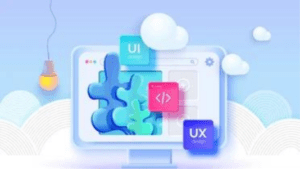Table of contents:
Introduction
- Background and Context
- Objectives
- Research Questions
- Methodology
Fundamentals of Website Design
- 1 Principles of Effective Web Design
- 2 Traditional Approaches to Web Design
- 3 Limitations and Challenges
Artificial Intelligence in Website Design: An Overview
- 1 Introduction to Artificial Intelligence
- 2 AI Techniques in Website Design
- 3 Benefits of AI in Website Design
- 4 Challenges and Limitations
AI-Powered Automated Design Processes
- 1 Automated Layout Generation
- 2 Intelligent Content Generation
- 3 Personalization and Customization
- 4 Responsive Design Optimization
AI-Enhanced User Experience
- 1 Natural Language Processing in Chatbots
- 2 Voice and Image Recognition for Enhanced Interaction
- 3 Intelligent Search and Recommendation Systems
- 4 Behavioral Analysis and Personalized Experiences
AI for Designers: Augmentation and Collaboration
- 1 Design Assistance and Inspiration
- 2 AI-Driven Collaboration Tools
- 3 Workflow Optimization and Efficiency
- 4 AI-Generated Design Feedback
Case Studies: Successful AI-Driven Website Design Projects
- 1 Case Study 1: The Impact of AI on E-commerce Design
- 2 Case Study 2: AI-Driven Web Personalization in Media Industry
- 3 Case Study 3: AI-Assisted Design Tools for Non-Designers
- 4 Case Study 4: AI-Optimized Responsive Design for Mobile
Ethical Considerations and Potential Risks
- 1 Bias and Fairness in AI-Driven Design
- 2 Privacy and Data Protection
- 3 Dependence on AI and Human Intervention
Future Directions and Emerging Trends
- 1 AI-Generated Aesthetics and Creativity
- 2 AI-Powered Virtual Reality (VR) and Augmented Reality (AR) Experiences
- 3 AI-Driven Web Accessibility and Inclusive Design
- 4 Human-Centered AI Design and User Empowerment
Conclusion
- 1 Summary of Findings
- 2 Implications for Website Design Industry
- 3 Final Remarks
1.1 Background and Context
In recent years, the field of website design has witnessed significant advancements in artificial intelligence (AI) technology. AI has become a powerful tool for designers, enabling them to automate various aspects of the design process and enhance user experiences. This introduction provides an overview of the growing role of AI in website design and sets the stage for a comprehensive analysis of its impact.
1.2 Objectives
The primary objective of this paper is to explore and analyze the role of AI in website design. It aims to investigate the benefits and challenges of integrating AI into the design process, examine specific AI-powered tools and techniques, and showcase successful case studies. Additionally, this paper seeks to discuss ethical considerations, potential risks, and emerging trends in the field.
1.3 Research Questions
What are the fundamental principles of effective web design, and how can AI enhance these principles?
What are the different AI techniques used in website design?
What are the benefits and challenges of incorporating AI into the design process?
How does AI automate design processes such as layout generation, content generation, personalization, and responsive design optimization?
In what ways can AI enhance the user experience through natural language processing, voice and image recognition, search and recommendation systems, and behavioral analysis?
How does AI augment and optimize the work of designers, facilitating collaboration and efficiency?
What are some notable case studies of successful AI-driven website design projects?
What ethical considerations and potential risks arise from AI integration in website design?
What are the future directions and emerging trends in AI-driven website design?
1.4 Methodology
This comprehensive analysis employs a multi-faceted methodology to address the research questions. It includes a review of relevant literature, analysis of case studies, examination of AI-powered tools and techniques, and consideration of ethical implications. The methodology incorporates a qualitative approach, drawing insights from real-world examples and expert opinions in the field of website design.
Fundamentals of Website Design
2.1 Principles of Effective Web Design
Before delving into the role of AI in website design, it is essential to understand the fundamental principles that underpin effective web design. These principles include visual aesthetics, usability, consistency, clarity, and accessibility. AI can significantly enhance these principles by automating design processes, optimizing layouts for different devices, and personalizing user experiences.
2.2 Traditional Approaches to Web Design
Historically, web design involved manual coding, graphic design, and user experience considerations. Designers created static layouts and handcrafted interactions. While this approach provided control and customization, it was time-consuming and often limited scalability. AI introduces a paradigm shift by automating and augmenting various design processes, enabling designers to focus on higher-level creativity and strategy.
2.3 Limitations and Challenges
Although AI brings significant advancements to website design, it also presents challenges. Some limitations include the potential for biased outcomes, difficulties in balancing automation and human intervention, and concerns regarding data privacy and security. Understanding and addressing these challenges are critical to ensuring responsible and effective use of AI in website design.
Artificial Intelligence in Website Design: An Overview
3.1 Introduction to Artificial Intelligence
Artificial intelligence encompasses a range of technologies that enable machines to mimic human intelligence. Machine learning, natural language processing, computer vision, and deep learning are among the core components of AI that have revolutionized website design. These techniques allow systems to learn, analyze data, and make informed decisions to automate and enhance design processes.
3.2 AI Techniques in Website Design
AI techniques in website design include automated layout generation, intelligent content generation, personalization and customization, and responsive design optimization. These techniques leverage algorithms to automate tasks, analyze user behavior, and create tailored experiences. They empower designers to efficiently deliver high-quality websites while focusing on creativity and strategy.
3.3 Benefits of AI in Website Design
The integration of AI in website design brings numerous benefits. It streamlines the design process, reduces time and cost, enhances user experiences, improves conversion rates, and enables scalability. AI-driven tools and techniques enable designers to work smarter and more efficiently, resulting in improved productivity and client satisfaction.
3.4 Challenges and Limitations
While AI offers immense potential, there are challenges to consider. Bias and fairness issues can arise when training AI models, and ensuring unbiased outcomes is a critical concern. Additionally, the overreliance on AI without human intervention can lead to generic and impersonal experiences. Addressing these challenges requires continuous monitoring, evaluation, and ethical considerations.
AI-Powered Automated Design Processes
4.1 Automated Layout Generation
AI algorithms can analyze design patterns and user preferences to generate optimized website layouts. By automating the process of organizing content, selecting typography, and arranging visual elements, designers can save time and focus on refining and customizing the generated layouts.
4.2 Intelligent Content Generation
AI-powered content generation tools leverage natural language processing to create written content, including product descriptions, blog posts, and social media captions. These tools can analyze existing content, identify patterns, and generate new content that aligns with the brand’s tone and style. Designers can then focus on fine-tuning the generated content and adding a personal touch.
4.3 Personalization and Customization
AI enables dynamic and personalized web experiences by analyzing user data, preferences, and behavior. By leveraging machine learning algorithms, websites can deliver tailored content, product recommendations, and user interfaces that adapt to individual users. This personalization enhances user engagement, satisfaction, and conversion rates.
4.4 Responsive Design Optimization
AI algorithms can automatically adapt website layouts and designs to different devices and screen sizes. This responsive design optimization ensures a seamless and consistent user experience across desktops, tablets, and mobile devices. By automating the process of adapting design elements, designers can ensure optimal usability without manual adjustments.
AI-Enhanced User Experience
5.1 Natural Language Processing in Chatbots
Chatbots powered by AI and natural language processing can provide interactive and personalized user experiences. They can understand user queries, provide instant responses, and offer recommendations. Chatbots enhance customer support, assist in product selection, and engage users in conversational interactions, resulting in improved user satisfaction and increased conversion rates.
5.2 Voice and Image Recognition for Enhanced Interaction
AI-driven voice and image recognition technologies enable intuitive and seamless interaction with websites. Voice assistants allow users to navigate websites, search for information, and complete tasks using voice commands. Image recognition capabilities facilitate image-based search, object identification, and augmented reality experiences, further enhancing user engagement.
5.3 Intelligent Search and Recommendation Systems
AI-powered search engines and recommendation systems analyze user behavior, preferences, and contextual information to deliver accurate search results and personalized recommendations. These systems improve content discoverability, facilitate user journeys, and increase conversion rates by presenting relevant and engaging options to users.
5.4 Behavioral Analysis and Personalized Experiences
AI algorithms can analyze user behavior, such as click patterns, navigation paths, and engagement metrics, to gain insights and create personalized experiences. By understanding user preferences, AI can deliver tailored content, suggest relevant products, and optimize user interfaces to maximize engagement and conversion.
AI for Designers: Augmentation and Collaboration
6.1 Design Assistance and Inspiration
AI tools can assist designers by providing inspiration, generating design variations, and suggesting improvements. Designers can leverage AI-generated options as a starting point and iterate on them to create unique and innovative designs. AI-driven tools enhance creativity, streamline the design process, and offer new perspectives.
6.2 AI-Driven Collaboration Tools
Collaboration is a vital aspect of website design projects, and AI can facilitate efficient teamwork. AI-powered collaboration tools enable real-time feedback, version control, and design element suggestions, allowing designers to work together seamlessly. These tools enhance communication, promote collaboration, and improve productivity among design teams.
6.3 Workflow Optimization and Efficiency
AI automates repetitive and time-consuming tasks, enabling designers to focus on more strategic and creative aspects of website design. From asset management to code generation, AI streamlines workflows, reduces human error, and improves efficiency. Designers can allocate their time and expertise to high-value activities, resulting in faster project delivery.
6.4 AI-Generated Design Feedback
AI algorithms can analyze design choices and provide feedback based on established design principles and user preferences. This AI-generated feedback helps designers evaluate and improve their work objectively. By receiving instant insights and suggestions, designers can iterate quickly and refine their designs for optimal results.
Case Studies: Successful AI-Driven Website Design Projects
7.1 Case Study 1: The Impact of AI on E-commerce Design
This case study examines how AI-powered recommendation systems and personalized user interfaces have transformed the e-commerce industry. It explores how AI analyzes user data, preferences, and behavior to deliver relevant product recommendations, resulting in improved user experiences, increased sales, and customer loyalty.
7.2 Case Study 2: AI-Driven Web Personalization in Media Industry
This case study investigates how AI-driven personalization techniques have enhanced user engagement and content discoverability in the media industry. It explores how AI analyzes user behavior, preferences, and demographic information to deliver personalized content recommendations, resulting in increased user satisfaction, prolonged website visits, and improved content monetization.
7.3 Case Study 3: AI-Assisted Design Tools for Non-Designers
This case study focuses on AI-powered design tools that empower non-designers to create visually appealing websites. It highlights how AI automates complex design processes, simplifies user interfaces, and offers intuitive design suggestions. Such tools enable individuals with limited design skills to create professional-looking websites, democratizing the website design process.
7.4 Case Study 4: AI-Optimized Responsive Design for Mobile
This case study explores how AI has revolutionized responsive design for mobile devices. It discusses how AI algorithms analyze screen sizes, device capabilities, and user preferences to automatically optimize website layouts for different mobile platforms. This AI-driven responsive design ensures seamless user experiences on mobile devices and improves mobile conversion rates.
Ethical Considerations and Potential Risks
8.1 Bias and Fairness in AI-Driven Design
AI algorithms are trained on existing data, which can introduce biases and perpetuate discriminatory outcomes. It is crucial to address bias in AI-driven design to ensure fairness and inclusivity. Designers should carefully select training data, monitor algorithm performance, and employ techniques to mitigate bias, such as diverse data representation and algorithmic transparency.
8.2 Privacy and Data Protection
The integration of AI in website design often involves collecting and analyzing user data. It is essential to uphold privacy rights, comply with data protection regulations, and implement robust security measures. Designers must prioritize data privacy, inform users about data collection practices, and obtain explicit consent for data usage to establish trust and protect user information.
8.3 Dependence on AI and Human Intervention
While AI can automate various design processes, it is crucial to maintain a balance between automation and human intervention. Designers should exercise creative control, review AI-generated outputs, and ensure that human expertise guides the final design decisions. Overreliance on AI without human oversight may lead to generic and impersonal designs that lack the human touch.
Future Directions and Emerging Trends
9.1 AI-Generated Aesthetics and Creativity
As AI technology advances, it holds the potential to generate novel design aesthetics and inspire creative solutions. AI algorithms can learn from vast design datasets and generate unique design variations that challenge traditional notions of aesthetics. AI-driven creativity tools may become an integral part of the designer’s toolkit, fostering innovation and pushing the boundaries of website design.
9.2 AI-Powered Virtual Reality (VR) and Augmented Reality (AR) Experiences
AI can enhance immersive experiences by integrating with virtual reality and augmented reality technologies. AI algorithms can analyze user interactions, preferences, and environmental data to personalize VR/AR experiences. This integration can revolutionize website design, enabling interactive and dynamic experiences that seamlessly merge the digital and physical worlds.
9.3 AI-Driven Web Accessibility and Inclusive Design
AI has the potential to improve web accessibility for users with disabilities. AI algorithms can analyze and interpret content to provide alternative formats, such as text-to-speech conversions and screen reader compatibility. By embracing inclusive design principles, AI-powered websites can cater to diverse user needs, fostering equal access and usability.
9.4 Human-Centered AI Design and User Empowerment
The future of AI in website design should prioritize human-centered design approaches. AI should be designed to empower users and enhance their capabilities, rather than replace human involvement. By focusing on user empowerment, designers can ensure that AI augments human creativity and decision-making, creating harmonious human-AI collaborations.
Conclusion
10.1 Summary of Findings
This comprehensive analysis has explored the role of AI in website design, discussing its impact on various aspects of the design process and user experiences. The findings highlight the benefits of AI-powered automation, improved user experiences through personalization and AI-driven interaction, and the augmentation of designers’ capabilities through AI-assisted tools and collaboration.
10.2 Implications for Website Design Industry
The integration of AI in website design has transformative implications for the industry. It enables designers to work more efficiently, deliver high-quality websites, and enhance user satisfaction. However, ethical considerations, such as bias and privacy, should be addressed to ensure responsible AI implementation. The industry must embrace a human-centered approach and leverage AI to empower both designers and users.
10.3 Final Remarks
As AI technology continues to advance, its role in website design will evolve. Embracing AI-driven innovations while addressing ethical concerns will be key to harnessing the full potential of AI in website design. By leveraging AI’s capabilities, designers can unlock new possibilities, enhance user experiences, and shape the future of web design.



